Teachable is an online platform that empowers creators to create & sell online courses, coaching services, memberships, and digital downloads.
And in this blog post, I’ll offer a step-by-step tutorial of Teachable’s most important features so you can make an informed decision about whether or not Teachable is the right course creation platform for you.
I recommend watching the full Teachable tutorial on the Wit & Wire YouTube channel here:
For full transparency, I was a Teachable employee for four years before I went full-time at Wit & Wire.
That said, I update my recommendations annually, and my former employment doesn’t affect my current recommendations. You can download the full side-by-side comparison here:
💡 The Course Creation Toolkit (free): Download our complete list of recommended tools and equipment for course creators, including our favorite course creation platforms.
Table of Contents
What is Teachable?
Teachable is a course creation platform that allows creators to build and sell online courses.
You can drag and drop in your own videos and PDFs to create a self-paced online course. You can also create sales pages and checkout pages to market and sell your course.
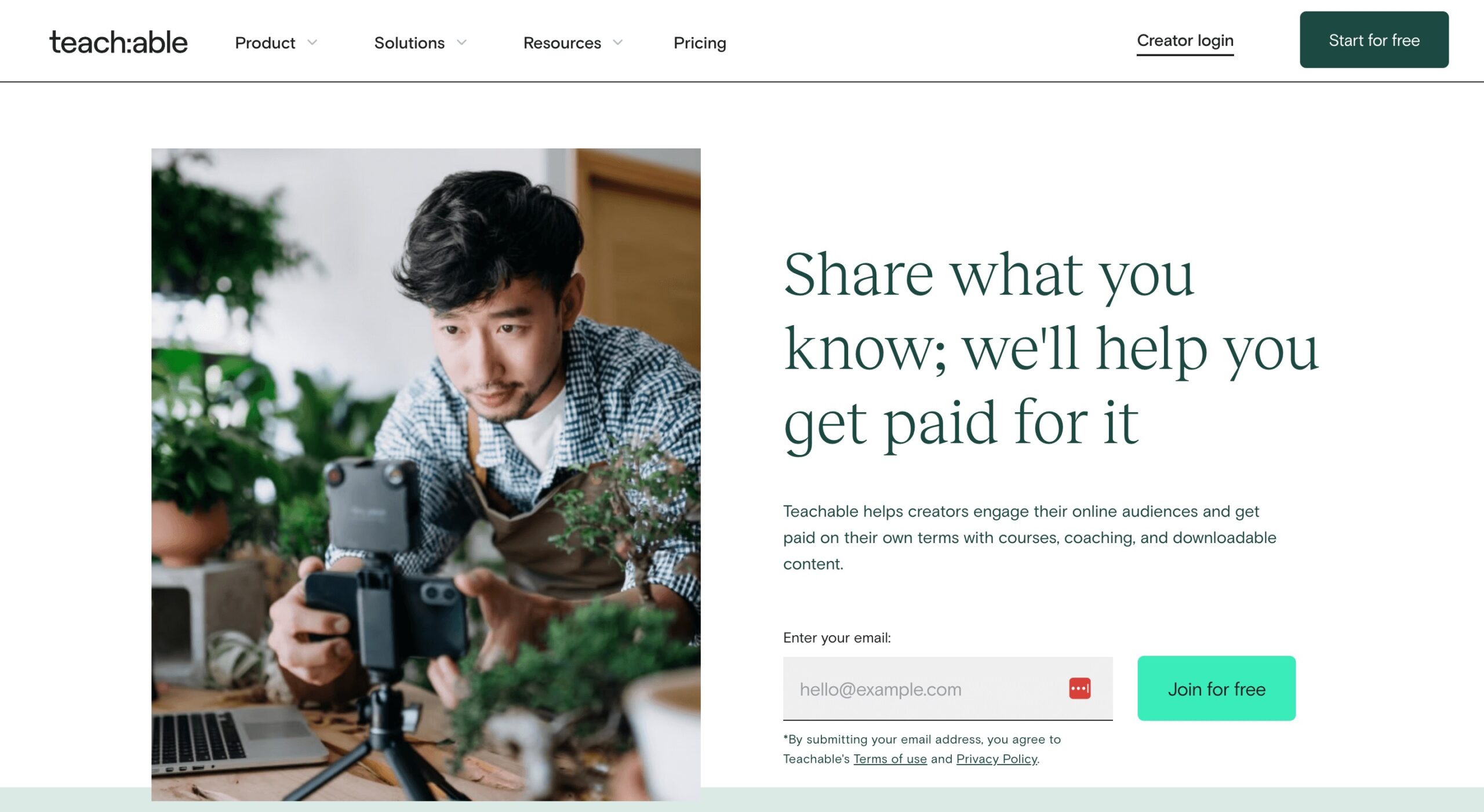
What is a course marketplace?
A course marketplace includes a catalog of courses created by independent instructors. Well-known examples include Udemy, Skillshare, and Coursera.
The advantage in a marketplace is exposure. But you’re limited in earning potential and business growth.
As an example, I have a very successful course on Skillshare with thousands of students enrolled. However, there is a large cap on the amount of income I can earn. In fact, I only earn about $100-$200 a month, and some of that money comes from referrals to Skillshare.
So for most online business owners, I recommend a course creation platform instead.
What is a course creation platform?
Unlike a marketplace, a course creation platform allows you to create and sell online courses through your own business.
It’s similar to building a website. You might use WordPress, Squarespace, or ShowIt to build your website, but visitors won’t know which tool you used. Additionally, you wouldn’t expect prospects to be able to find your website by visiting Squarespace’s website.
Your earning potential is unlimited (and uncapped) and you have full control of your pricing. You also retain student email addresses so you can stay in touch and market to them in the future.
I recommend course creation platforms for all online business owners ready to scale. And since Teachable is one of the most well-known platforms, I’m excited to share how it works.
Teachable plan comparison
Firstly, you’ll need to create your Teachable account. I usually recommend starting on the free plan to test things out, and then you can upgrade as needed:
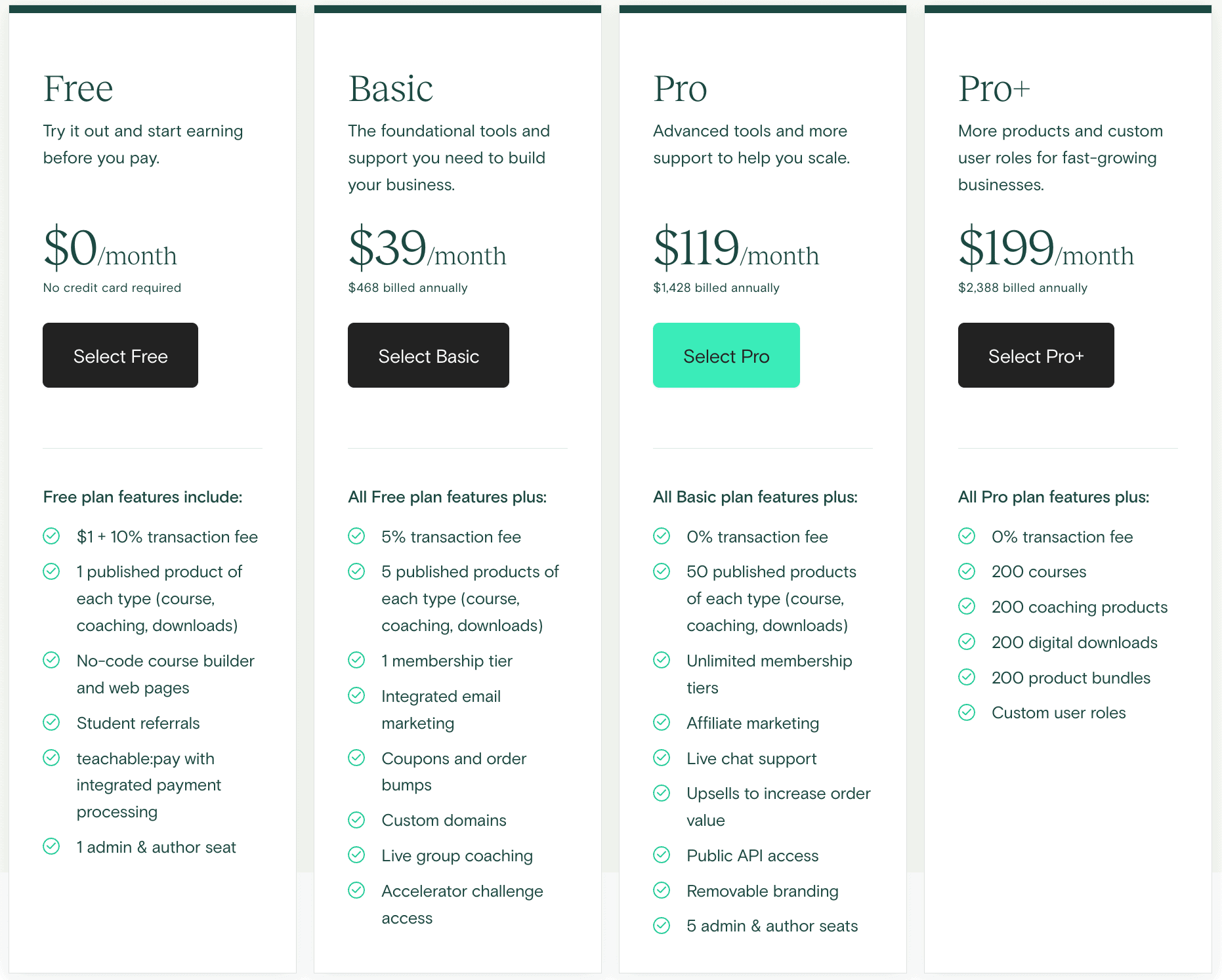
Free Plan: Teachable allows you to create one course on the free plan, although it’s notable that there are additional transaction fees for each sale.
Basic Plan: When you’re ready to publish more products, or if you’re selling at scale, I recommend the basic plan. Other noteworthy features include coupon creation and the opportunity to use a custom domain.
Pro Plan: If you start selling at a certain volume, I recommend the Pro Plan, which has 0% transaction fees. There are also advanced features, which you can browse on Teachable’s website.
Teachable tutorial: feature walkthough
When you first create your Teachable account, you’ll be taken to the Admin Dashboard. Specifically, you’ll see a “Get Started” screen at the top of your sidebar menu, which includes the recommended onboarding steps for new Teachable users:
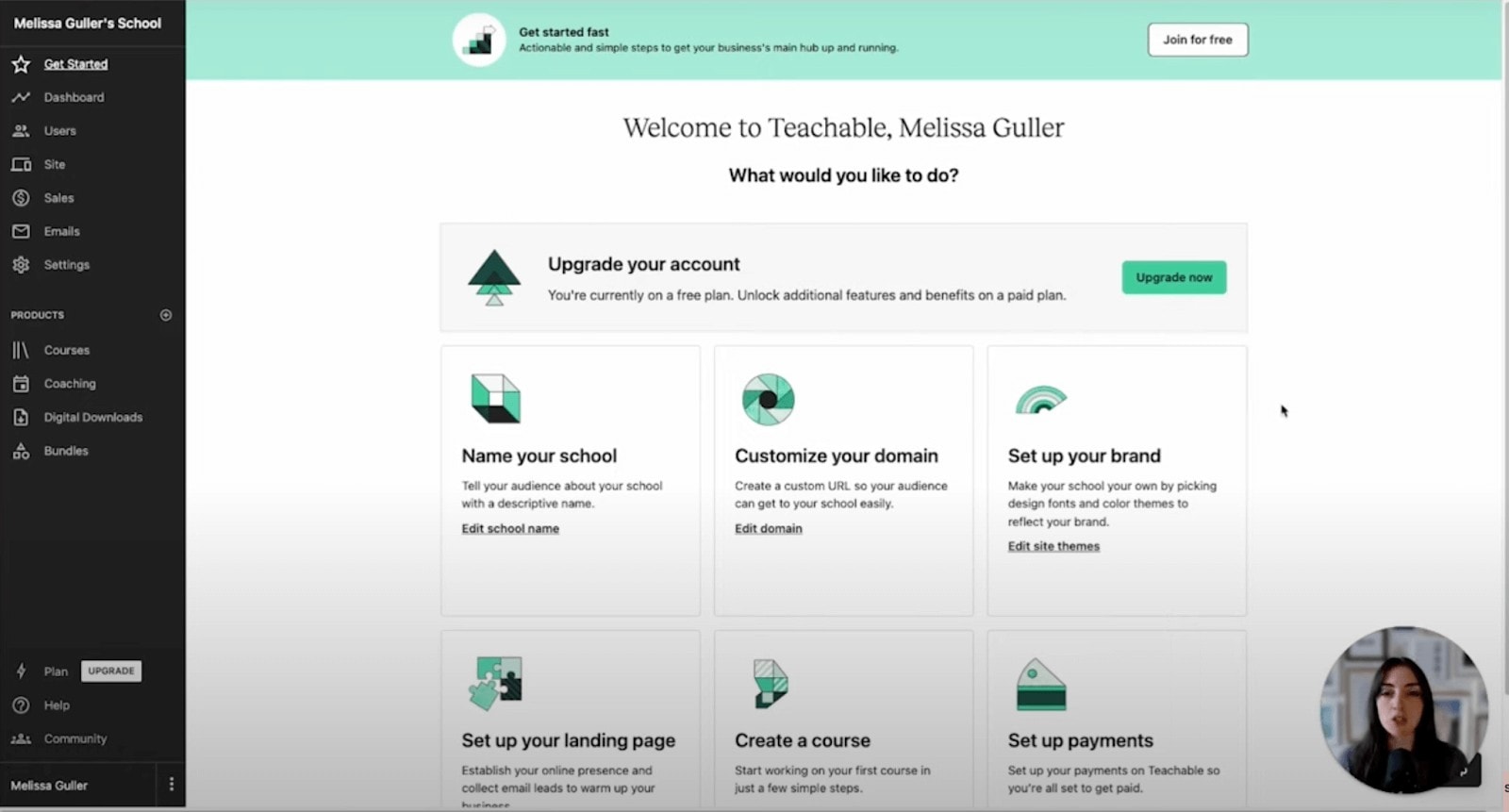
Within your Admin Dashboard, you’ll see a navigation menu on the left side of your screen. Each main menu will open up a submenu, but here are the main categories:
- Dashboard: View your recent sales and high-level analytics.
- Users: View all people associated with your school, including admins, authors, affiliates, and students.
- Site: Customize the branding of your school as well as the homepage, terms and conditions, and course sales pages.
- Sales: This database tracks all transactions for both paid and free enrollments in your school.
- Emails: Modify the transactional emails sent out to your students. This is not a full email marketing platform; for example, you can’t send weekly newsletters or sales emails to non-buyers.
- Settings: Manage your account, including your business info, billing info, and tax details.
1. Update information about your school
Within your settings, you’ll have the option to update basic information about your school. I recommend updating your school name to match the name of your business, most importantly.
After that, you might also want to change the email sender name (this is what your students will see on their transaction receipts), your business name, and add your mailing address for tax reporting purposes.
You’ll also notice there is a ‘Publish School’ button in the top right corner. Clicking this button will take your account live, which means that if a student were to visit the URL for your Teachable school, they would see it. Right now, your school is unpublished so if they were to visit the URL they would see a ‘Coming Soon’ screen.
When you’re ready for your school to go live, you’ll want to come back and click ‘Publish’. However, if you wanted to publish your school now, you absolutely could as your students won’t actually be able to find your school unless you send them the link. It’s just like when you publish a real website – it’s not immediately going to alert the whole internet until you invite others to view it.
2. Branding your school
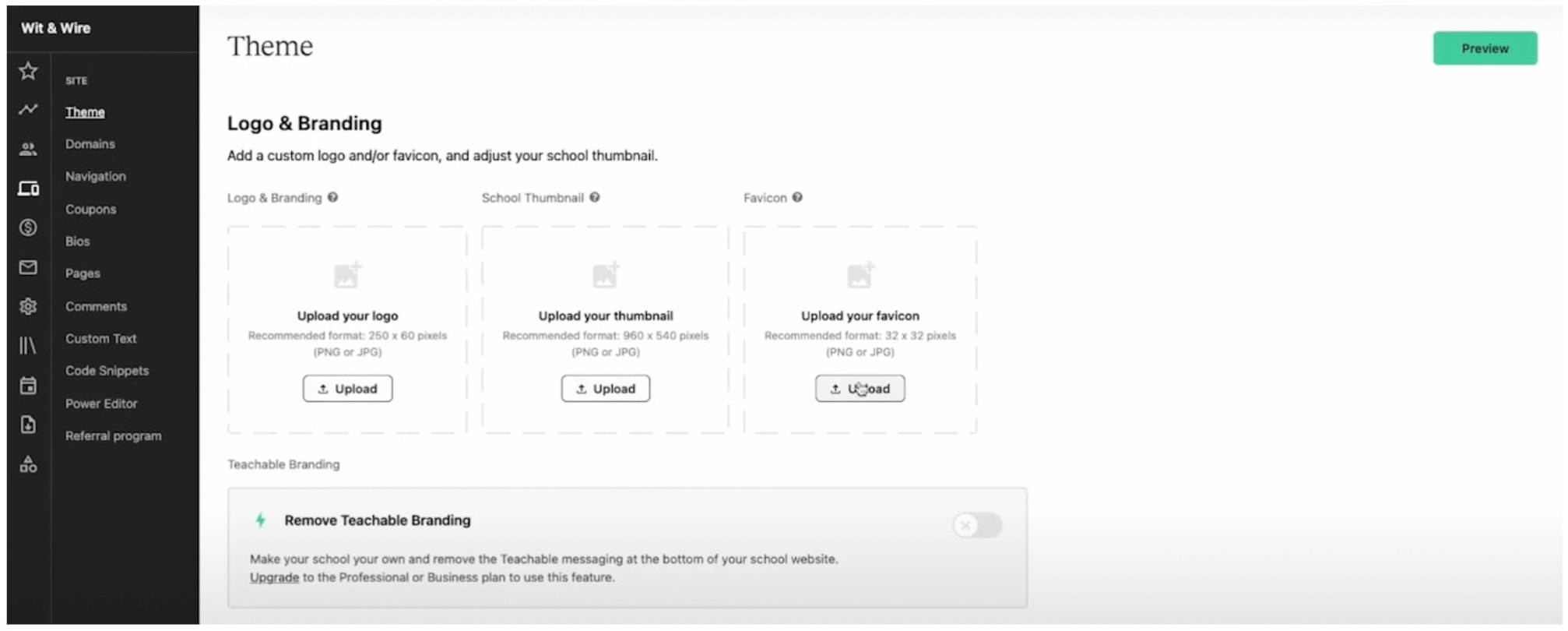
Now that we’ve updated your basic school information, it’s time to customize and brand your school to match your business. To do this, you’ll need to navigate to the ‘Site’ tab on the main menu. When you click on this tab, it will bring up the Site submenu, which you can see in the image above.
Within your site settings, you’re able to:
- Upload your logo, school thumbnail & favicon
- Choose your brand fonts
- Update your brand color palette
3. Add a custom domain
If you have the Basic plan, or above, you can set a custom domain for your school. You’ll find this option in the ‘Site’ tab underneath ‘Domains’.
By default, your Teachable account comes with a free Teachable domain automatically generated for you. (For example, mine was witandwire.teachable.com.)
On Basic plans and up, you can switch to a custom domain or subdomain. For example, I use courses.witandwire.com as the custom subdomain for Wit & Wire’s online courses.
4. Update your instructor bio
When students enroll in a course, they’ll be able to see the bio of the course instructor – you. You’ll want to update this with a headshot of yourself and a brief bio about yourself.
You can update your bio by navigating to the ‘Site’ tab and clicking on ‘Bios’.
5. Create your school homepage & site pages
On the ‘Pages’ subsection underneath the ‘Site’ tab, you’ll find an option to update your site pages.
When you come to this page, you’ll notice that there are two different tabs:
- School pages include pages like your Homepage and your Student Dashboard
- Product Pages include sales pages for any of your courses and/or digital products
6. Create your online course
To create your first course, you’ll need to navigate to the ‘Courses’ icon and select the ‘New Course’ button. Here, you can enter the name of your course and the author, and then you’ll be ready to start uploading curriculum.
If you head to the ‘Information’ subtab, you can also add a course image, which is the thumbnail that represents your course in the student dashboard.
(By the way, you can easily change your course name and any details anytime.)
If you have the Pro plan (or higher), you also have the option to set course compliance rules. These control how students go through the curriculum. For example, if it’s important to you that students watch the lessons in order, or that they finish watching videos, then you can enforce that as a rule here.
You can also update your default post-purchase page – where you want your students to be sent once they’ve purchased your course. Usually, they would be redirected to a thank you page, but you could change this to redirect them straight into the enrolled curriculum if you prefer.
7. Creating your course sales page
Teachable allows you to create sales pages for your online course within their native builder. If you don’t have a website, this is a great way to get started and have a professional sales page leading to your course.
If you do have your own website, however, you may choose to create the sales page on your own website and then direct any links to your checkout page.
8. Setting your course pricing
Under the ‘Courses’ tab, you’ll want to navigate to ‘Pricing’ so set your course price.
Here, you’ll have a few options, and you can add one or more price points to any course:
- Free: Students don’t pay to enroll
- One-time purchase: Students pay up front (in full) to enroll
- Payment plan: Students pay in installments over a series of time (ex: 4 payments of $250)
- Subscription: Members pay an ongoing fee, which is continuously charged until cancelled
For online courses, your pricing will typically be either a one-time purchase or a payment plan.
However, you can choose for your course to have multiple pricing options. For example, let’s say you’re selling your course for $500. You can set a one-time price of $500 for your students to pay in full, or you can give them a second option of a payment plan that splits into two payments of $250.
🎥 Watch the full YouTube tutorial here
9. Customize your checkout page
A checkout page allows buyers to complete a transaction and enroll in your course or digital product.
One of Teachable’s notable advantages as a course platform is the fact that they’re a Merchant of Record, which allows them to offer advanced payment support, such as automatic affiliate payout and tax calculation at checkout.
With Teachable, each checkout page corresponds to one price point for one digital product. You have the option to add testimonials, bullet points about your course, and/or a satisfaction guarantee, and I’m personally a fan of including all three.
Optionally, you can also add an order bump, which will allow buyers to purchase an add-on product at checkout.
10. Add your course curriculum
Curriculum includes the all of the videos and lessons needed for a student to go from start to finish and reach their outcome.
So when you create your curriculum, you’ll start by outlining your sections and lectuers:
- A section is a group of related lectures.
- A lecture is an individual lesson that focuses on one key concept. It often includes a video, but may also include text, PDFs, or other resources.

You can either create your curriculum from scratch or use Teachable’s AI Curriculum Builder to generate sections and lessons.
Within any individual lesson, you can add videos, PDFs, text, and more. And with their block-based curriculum builder, I love how much you can customize each lesson to suit the material.
(See the full video tutorial for the walkthrough.)
11. Add an order bump
An order bump is an add-on product on your checkout page that gives your buyers the opportunity to check a box and add an additional product to their purchase.
It’s typically a special offer (i.e. price point) not found elsewhere, which adds authentic urgency to the purchase.
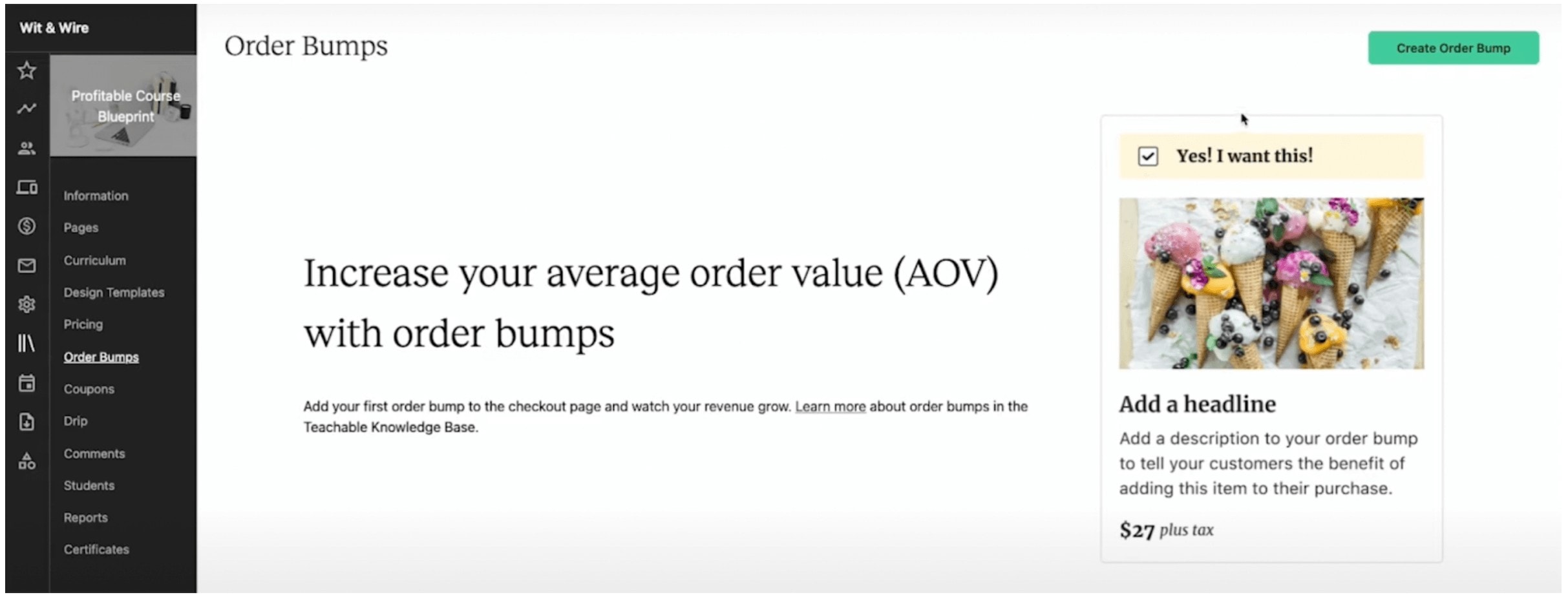
Order bumps are a great way to increase your average order value (AOV) by allowing buyers to upgrade their experience through related products. And although this might not be something that you implement right away, it’s a great feature to consider as you scale.
12. Publish your course
Now that you’ve created everything you need to sell your online course, it’s time to publish it! To do this, head back to the course you created and click the ‘Publish Course’ button.
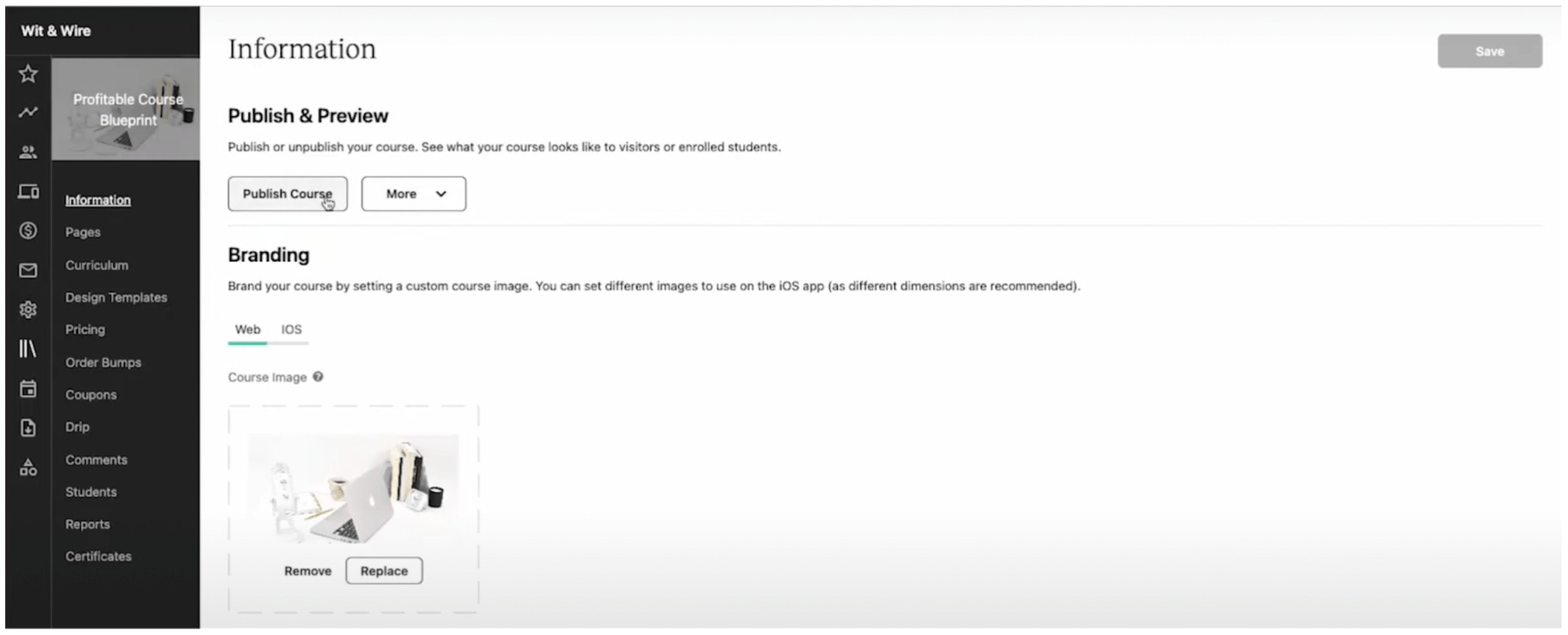
If you have lessons you’re still working on that are currently in draft mode, you may receive a notification asking if you want to publish these unpublished lectures. If they’re not yet ready for your students, make sure to click ‘No, just publish the course’.
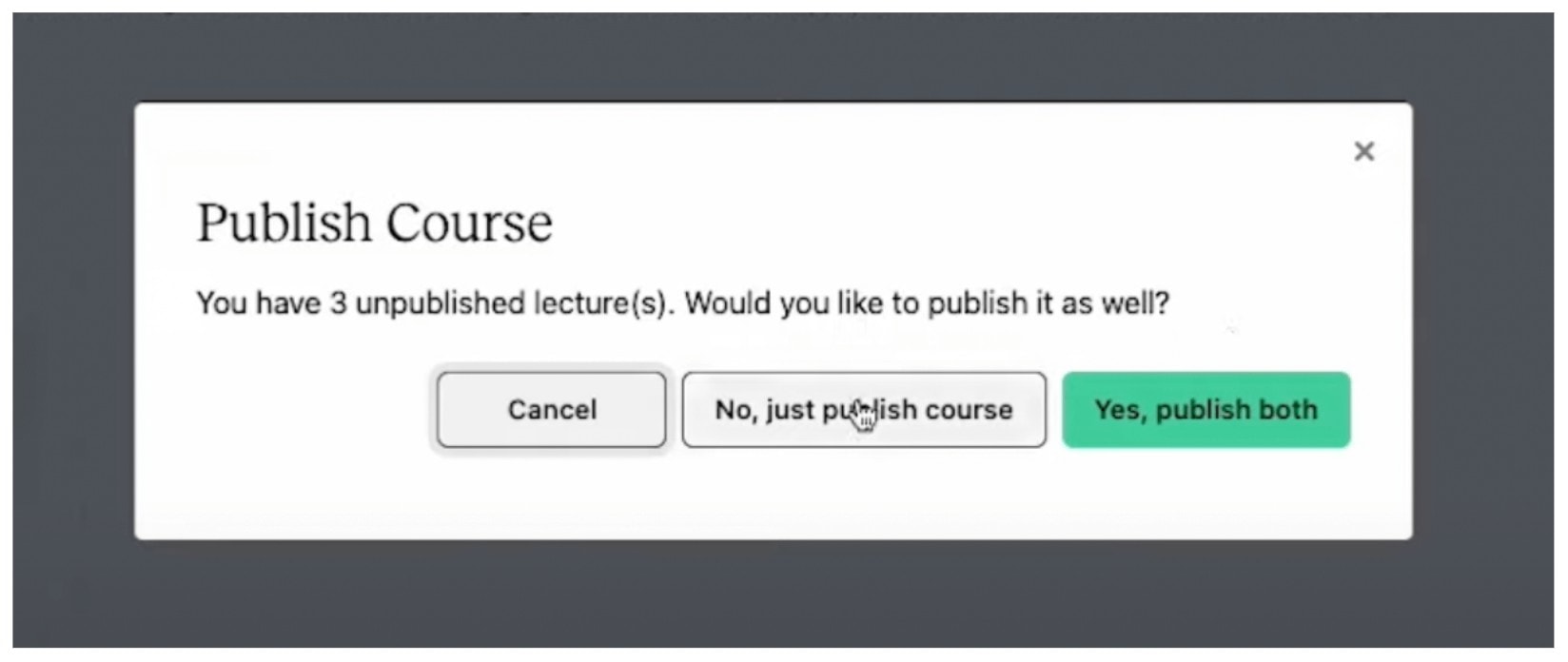
Once your course is published, your sales page will be visible within your school for anybody who wants to purchase and students will be able to access and consume the course:
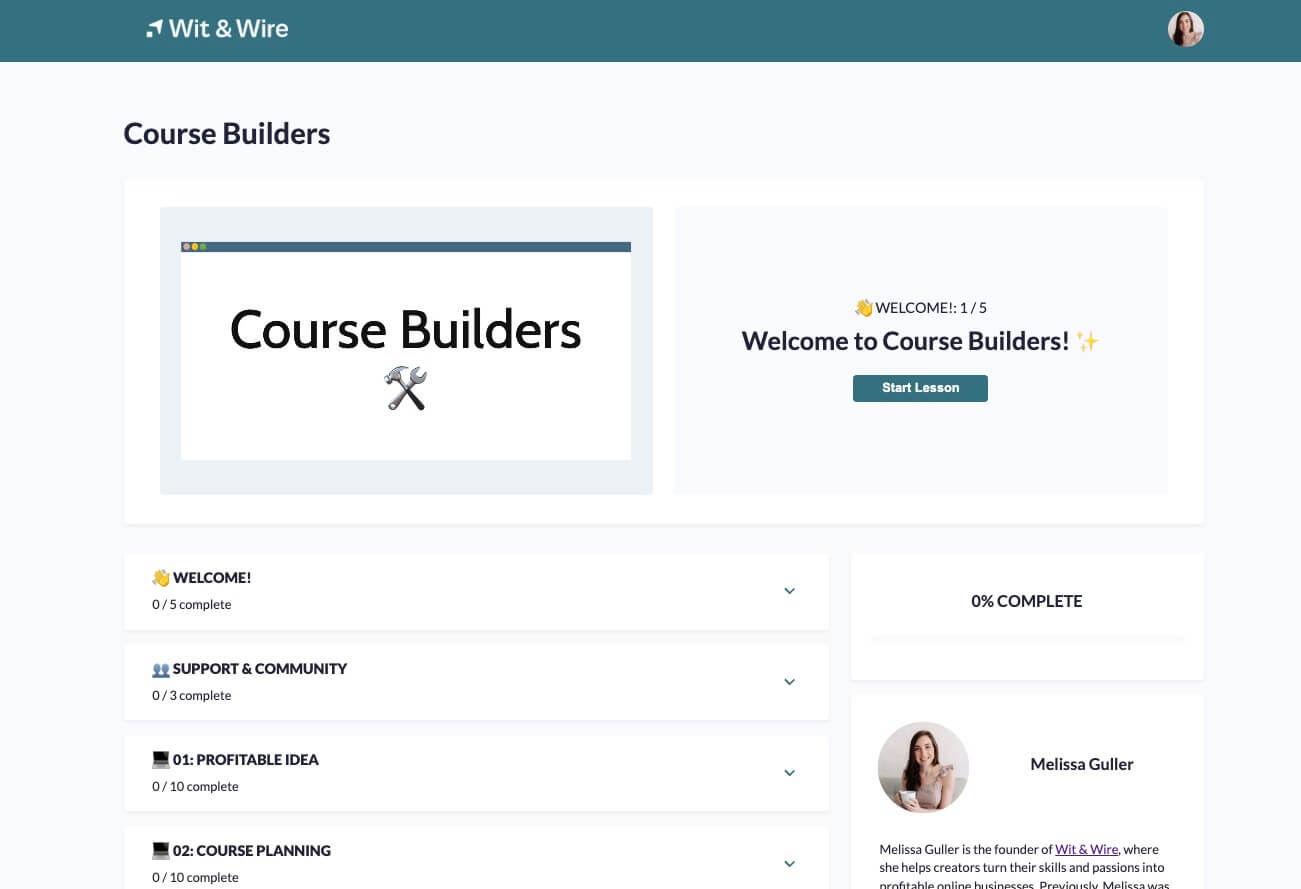
13. Publish your school
Publishing your school makes it accessible to visitors and students and is required before you can enroll any students into your Teachable school.
- To publish your school, navigate to the ‘Settings’ tab and under ‘General’, you’ll find a button that says ‘Publish School.’
- Once you click this button, your school will be live and visible to anyone who visits
Final thoughts on Teachable for online course creators
Teachable is a great course creation platform for many online business owners. And although they aren’t an all-in-one platform (like Kajabi) or a community-powered platform (like Circle), if what you need is a classic course platform with a best-in-class curriculum builder, then Teachable could be a great option.
If you’re curious to check it out, you can create a free Teachable account here.
And if you’re wondering how Teachable stacks up against comptitors, then I recommend our free Course Course Toolkit, which includes an extended side-by-side comparison of my current recommended course creation platforms.
📈 Free Download: The Course Creation Toolkit

Melissa Guller is the founder of Wit & Wire, where we help everyday experts become profitable course creators. She previously worked full-time for Ramit Sethi, Teachable, and General Assembly. Today, she shares simplified tech tutorials and modern marketing strategies through our blog, YouTube, and Wit & Wire Weekly newsletter
